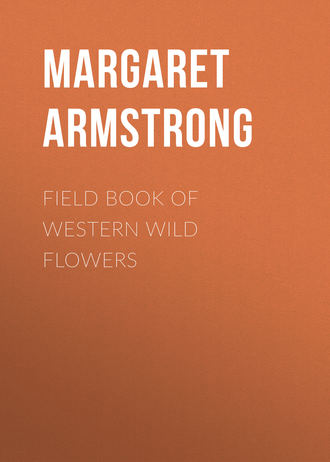 полная версия
полная версияField Book of Western Wild Flowers
Pretty Bird-foot
Anisolòtus formosíssimus (Lotus) (Hosackia)
Pink and yellow
Spring
Wash., Oreg., Cal.
A gay and charming kind, with smooth stems, spreading on the ground, light green leaves, with five or more leaflets, and flowers about half an inch long, with a golden-yellow standard, pink or magenta wings and wine-colored keel, forming a flattish cluster, the contrasting colors giving a vivid effect. This grows in damp places along the sea-coast.
Bird-foot
Anisolòtus argyraèus (Lotus) (Hosackia)
Yellow
Spring
California
A shrubby, branching plant, a foot and a half high, forming a pretty clump, two or three feet across, with downy, gray-green stems and foliage, sprinkled with clover-like heads of yellow flowers. The leaflets are slightly thickish, covered with silky down, the twigs and young leaves silvery-white. The small flowers are a soft shade of warm-yellow, and the buds form neat, fuzzy, silvery balls. This grows on dry hillsides in the Catalina Islands.
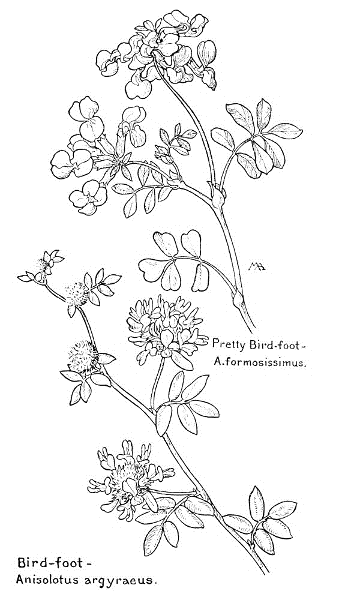
Pretty Bird-foot – A. formosissimus.
Bird-foot – Anisolotus argyraeus.
Anisolòtus strigòsus (Lotus) (Hosackia)
Yellow
Spring, summer, autumn
California
This is only a few inches high, with slender, slightly downy stems, branching and spreading, and bright green leaves, with seven or more, small, narrow leaflets, slightly thickish, with some minute, bristly hairs. The few flowers are about a quarter of an inch long, mostly single, bright yellow, tinged with red, fading to orange, and have a sort of miniature prettiness. This grows in the south.
Bird-foot
Anisolòtus decúmbens (Lotus) (Hosackia)
Yellow
Summer
Northwest
An attractive little perennial, forming low clumps, harmonious in coloring, of pale gray-green, downy foliage, sprinkled with small clusters of charming little flowers, each less than half an inch long, various shades of yellow, and arranged in a circle. The pods are hairy and it grows on sunny, sandy slopes.
Deer-weed
Anisolòtus glàber (Lotus) (Hosackia)
Yellow and orange
All seasons
California
Though the flowers are small and the foliage scanty, the shaded effect of mingled yellow and orange of these plants is rather pretty, as we see them by the wayside. The many, long, smooth, reed-like stems grow from two to five feet high, branching from the root, somewhat woody below, loosely spreading, or sometimes half lying on the ground. The leaves are almost smooth, very small and far apart, with from three to six, oblong leaflets, and the flowers, from a quarter to half an inch long, are clustered in close little bunches along the stem, forming long wands, tipped with green buds, and shading downward through the bright yellow of the larger buds to the orange of the open flowers and the dull red of the faded ones. The pod is incurved, tipped with the long style. This is common and widely distributed, a perennial, but said to live only two or three years. In the south it often makes symmetrical little bushes, pleasing in appearance. It is a valuable bee-plant. A. Wrìghtii of Arizona, Utah, New Mexico, and Colorado, is quite leafy, with erect stems and branches, bushy and woody at base, the small leaflets from three to five in number. The flowers, without pedicles, are much like the last, but over half an inch long, yellow becoming reddish, with a blunt keel, and scattered all over the plant.
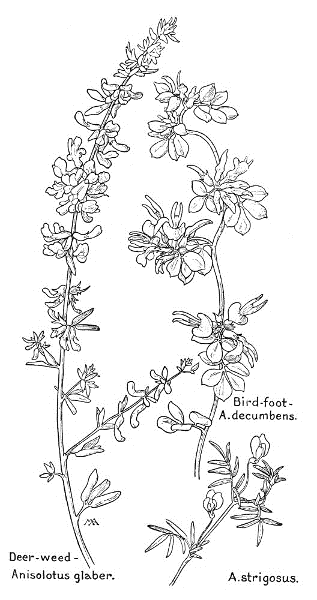
Bird-foot – A. decumbens.
Deer-weed – Anisolotus glaber.
A. strigosus.
There are several kinds of Thermopsis, of North America and Asia; stout, perennial herbs, with woody rootstocks; leaflets three; stipules conspicuous, leaf-like; flowers large, yellow, with short, bracted flower-stalks; calyx bell-shaped, five-cleft; standard broad, in the western species, shorter than the oblong wings, keel nearly straight, blunt, the same length as the wings; stamens ten, separate, curving in; style slightly curving in, stigma small; pod flat, long or oblong, straight or curved, with a very short stalk and several seeds. Thermopsis, sometimes called False Lupine, is distinguished from Lupinus by its stamens, which are separate, instead of united into a sheath. The Greek name means "lupine-like."
Golden PeaBuck-bean
Thermópsis montànà
Yellow
Spring, summer
Northwest, Utah, Ariz.
A very handsome, thrifty-looking plant, about two feet high, the smooth, bright green foliage contrasting finely with the clusters of clear yellow flowers, each about three-quarters of an inch long. The erect, straight pods, two or three inches long, are silky and also the calyxes and buds. This thrives in the mountains, up to an altitude of nine thousand feet, in somewhat moist spots, and its fresh coloring is most attractive. The foliage seems to me to be especially handsome in northern Arizona, but these plants are also beautiful in the Utah canyons. The flowers are scentless and last a long time in water. T. Califórnica has silvery, silky foliage and is common in California, in damp ground in the hills.
There are many kinds of Parosela, of western North America, Mexico, and the Andes, no one sort common; generally shrubs; leaves almost always compound; leaflets odd in number, small, toothless, with minute stipules, often with glandular dots; flowers small, in terminal clusters; calyx with nearly equal, long, occasionally feathery teeth; corolla with wings and keel longer than the standard, their claws adhering to the lower part of the stamen-tube, but the claw of the small, heart-shaped standard free; stamens nine or ten, filaments united, anthers alike; ovary with a short stalk, or none, style awl-shaped; pod small, membranous, included in the calyx, usually with one seed. P. spinòsa, the Smoke Tree, or Ghost Tree, of western Arizona, is almost leafless, with grayish or whitish branches.
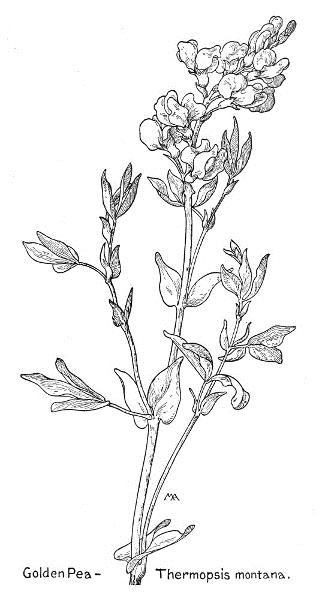
Golden Pea – Thermopsis montana.
Parosèla Califórnica (Dalea)
Blue
Spring
California
This little spiny desert shrub grows two or three feet high and is conspicuous on account of the odd contrast in color between its foliage and flowers. The woody stems and branches are very pale in color and the very small leaflets, so narrow and stiff that they look like evergreen needles, are covered with pale down and have glandular dots. All over this colorless foliage are sprinkled small spikes of indigo-blue flowers, so dark in color that the effect, against a background of desert sand, is of pale gray, speckled with black. It has a pleasant smell like balsam.
Parosèla Émoryi (Dalea)
Magenta
Spring, summer
Southwest
A low, desert shrub, with slender, abruptly branching stems and small, soft, thickish leaves, usually with three leaflets, obscurely toothed, the stems and leaves all thickly covered with white down. The flower-clusters are about three-quarters of an inch across, like a small clover-head, the woolly calyxes giving a yellowish-gray effect to the whole cluster, which is ornamented with a circle of tiny purple flowers. The effect of these specks of dark color on the pale bush is odd; the plant smells like balsam and grows in sandy soil.
Chaparral Pea
Xylothérmia montàna (Pickeringia)
Crimson
Spring, summer
California
This is the only kind, an evergreen shrub, flourishing on dry hills in the Coast Ranges, with tough, crooked branches and stout spines, forming chaparral so dense that it is impossible to penetrate. It grows from three to eight feet high, the gnarled, knotty, black branches terminating in long spines, which are often clothed with small leaves nearly to the end, the leaves with one to three, small leaflets and without stipules. The bush is often covered with quantities of pretty, bright, deep purplish-pink flowers, three-quarters of an inch long, forming a fine mass of color. The calyx has four, short, broad teeth; the petals are equal, the standard roundish, with the sides turned back and a paler spot at base, the wings oblong, the keel straight; the filaments of the ten stamens not united; the pod is two inches long, flat, straight, sickle-shaped when young. This very rarely produces fruit. Stevenson was probably describing this shrub when he wrote, "Even the low thorny chaparral was thick with pea-like blossoms."
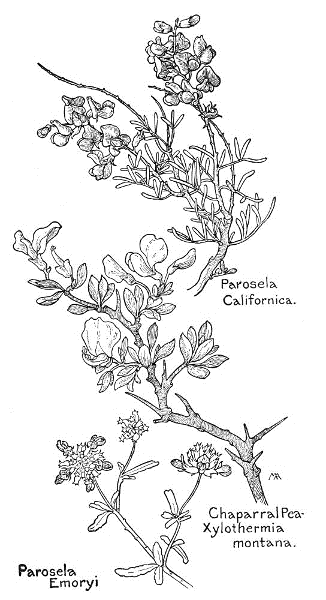
Parosela Californica.
Chaparral Pea – Xylothermia montana.
Parosela Emoryi.
There are so many western kinds of Lupinus that it is hopeless for the amateur to distinguish them; herbs, sometimes shrubs; leaves palmately-compound, stipules adhering to the base of the leaf-stalk, leaflets, more than three in number, usually closing at mid-day; flowers showy, in terminal racemes; calyx deeply toothed, two-lipped; standard broad, the edges rolling back, wings lightly adhering above, enclosing the incurved, pointed keel, sometimes beaked; style incurved, stigma bearded; stamens united by their filaments, alternate anthers shorter; pod two-valved, leathery, flat, oblong; seeds two to twelve. Lupines always have palmately-divided leaves, and are never trailing, twining, or tendril-bearing and thus may be superficially distinguished from Vetches and Peas, and from Thermopsis, by the united stamens.
River Lupine
Lupìnus rivulàris
Blue and white and purple
Summer
Northwest
A stately perennial, about three feet high, with stout, branching reddish, slightly downy stems, bearing several tall spires of flowers. The handsome leaves are bright green, smooth on the upper side, slightly downy, but not silvery, on the under, with from seven to thirteen leaflets, and the flower-cluster is very erect and compact, eight or ten inches long, beautifully shaded in color, from the pale, silky buds at the tip, to the blue and purple of the open flowers, which are about five-eighths of an inch long, with a lilac standard, tipped with purple. The upper flowers have white wings, veined with blue, and a green calyx, with reddish teeth, and the lower flowers have bright blue wings, veined with purple, and a reddish-purple calyx. This grows in wet places.
Tree Lupine
Lupìnus arbòreus
Yellow
Spring
California
A conspicuous shrub, four to eight feet high, with a thick trunk, gnarled and twisted below, with purplish, downy branches, silvery twigs and dull bluish-green leaves, downy on the under side, with about nine leaflets. The fine flower clusters are sometimes a foot long, composed of beautiful canary-yellow flowers, deliciously sweet-scented. This is easily recognized by its size and fragrance and is common in sandy soil near the sea, where it has been found very useful, as its very long roots keep the sand dunes from shifting.
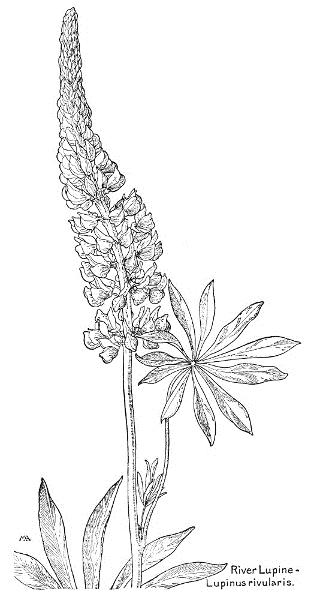
River Lupine – Lupinus rivularis.
Parti-colored Lupine
Lupìnus Stìversii
Pink and yellow
Summer
California
One of the prettiest and most conspicuous kinds, for its coloring is unusual, with branching, downy, leafy stems, about a foot high, thickish leaflets, pale bluish-green in color and rather hairy, and fragrant flowers, over half an inch long, with rose-colored wings and a yellow standard, changing to orange in fading. The combination of pink, orange, and yellow is very striking. This grows in warm, dry spots in Yosemite, and other places in the Sierras and Coast Ranges. L. citrìnus, of similar situations, has all yellow flowers.
Quaker Bonnets
Lupìnus laxiflòrus
Blue
Spring, summer
West
A handsome perennial, forming fine clumps on dry, gravelly hillsides, with several, slender, rather downy stems, from one to two feet tall, the leaflets six to nine in number, rather bluish-green, downy on the upper side, paler and silkier on the under. The younger leaves and calyxes are silvery with down, the flower buds form long, pretty, silvery clusters, resembling ears of wheat in form, and the flowers are in handsome loose racemes, from five to six inches long, of various shades of blue, mostly bright and somewhat purplish, the standard with a little white at its base and the keel purplish. The pod is covered with silky hairs and contains from three to five seeds. This is very common in Utah, handsome and conspicuous, and when growing in quantities, among Balsam-roots, Forget-me-nots, and Wild Geraniums, makes a combination unequaled in any flower-garden.
Milk-white Lupine
Lupìnus lactèus
White
Spring
California
A handsome plant, with a very stout, branching stem and soft, bluish-green leaves, with silky hairs on the edges and under sides, forming a fine clump of foliage, from which the flower-stalks stand up very stiff and straight. The cluster is most symmetrical in form and the flowers, which are nearly three-quarters of an inch long, are a beautiful, pearly white, tinged with yellow at the base of the standard and with creamy buds. The lower lobe of the calyx is large and very dark green, the stems have a pale, satiny surface, sprinkled with hairs and the leaflets are ten or eleven in number. This grows in the grass along the roadsides and is common around San Bernardino.
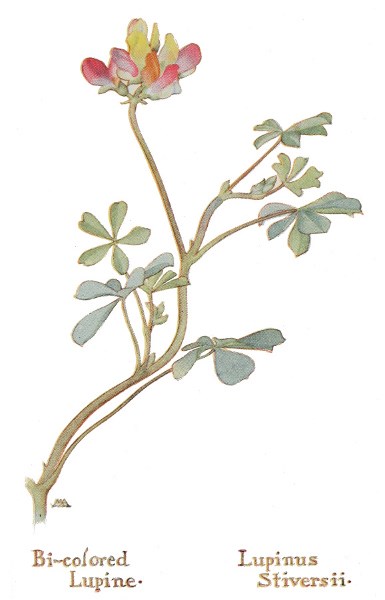
Bi-colored Lupine – Lupinus Stiversii.
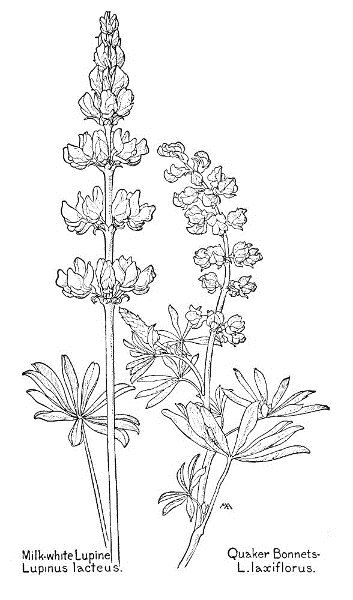
Milk-white Lupine – Lupinus lacteus.
Quaker Bonnets – L. laxiflorus.
There are numerous kinds of Lathyrus, widely distributed and difficult to distinguish. In technical character and habit they very much resemble Vetches, but sometimes have no tendrils and the flowers are larger, the leaflets are broader, and the style is flattened and hairy, not only at the tip, but also along the upper side. The leaflets are equal in number, the leaf-stalk usually terminating in a branching tendril; the flowers are in clusters; the calyx with five teeth, the upper commonly shorter; the style flattened and usually twisted; the pod flat or cylindrical, with no partitions between the seeds. Lathyrus is the old Greek name of the Pea.
Narrow-leaved Sweet Pea
Láthyrus graminifòlius
Pink and violet
Spring
Arizona
This has flowers resembling the cultivated Sweet Pea, but the whole effect is more airy and graceful. It is a loosely-trailing vine, with slender, angled stems, long, narrow leaflets, eight in number, and three-cleft tendrils. The flowers are about three-quarters of an inch long, brightly yet delicately tinted with shaded pink and violet, and are so lightly poised on the long slender stalks that they look like a row of butterflies about to take flight. This grows on the plateau in the Grand Canyon and all through Arizona in the mountains.
Utah Sweet Pea
Láthyrus Utahénsis
Lilac
Spring, summer
Utah, Col.
A smooth, trailing perennial, very graceful, with beautifully tinted flowers and bright green foliage. The stipules are large, broad and leafy, and the leaflets are usually ten in number, veined and thin in texture, one or two inches long, with tendrils. The flowers are nearly an inch long, from four to eight in a cluster, on a long flower-stalk; the standard pinkish-lilac, delicately veined with purple, the wings pale lilac and the keel cream-color. The flowers, as they fade, although keeping their form, gradually change in color to all shades of blue, turquoise, and sea-green, finally becoming buff, so that the effect of the whole cluster is iridescent and very lovely. This grows on mountain slopes, often in oak-thickets, clambering over the bushes to a height of several feet and clinging to everything with its tendrils.
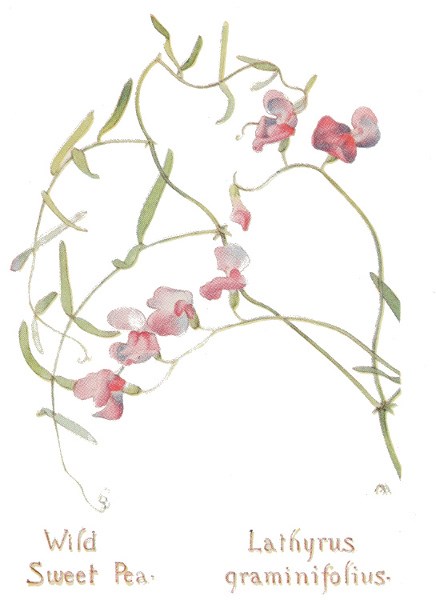
Wild Sweet Pea – Lathyrus graminifolius.

Utah Sweet Pea – Lathyrus Utahensis.
Pride of California
Láthyrus spléndens
Crimson
Spring
California
This has such glorious flowers, so superb in color and form, that it is by far the handsomest of its kind and not to be mistaken for any other. The stout, smooth, stems are dark green, the stipules small, and the leaves are smooth, slightly thickish and stiffish, rather dark bluish-green, with about ten leaflets. The flowers are over two inches long, from the tip of the standard to the end of the keel, and form a massive cluster of eight or ten blossoms, hanging on drooping pedicels and shading in color from the pale-salmon of the buds to the brilliant rose, carmine, and wine-color of the open flowers, the older flowers being very dark and rich. Only a small part of the flower-cluster is given in the picture. These plants, which are found around San Diego and farther south, clamber over the neighboring bushes to a height of several feet and adorn them with wonderful color, giving an effect of tropical splendor.
There are innumerable kinds of Astragalus; most abundant in Asia, usually perennial herbs, sometimes woody; leaves usually with numerous leaflets, flowers narrow, in spikes, with long flower-stalks; calyx tube-shaped, with nearly equal teeth; petals usually narrow, with slender claws, standard erect and somewhat oblong, wings oblong, keel with blunt tip, about the same length as the wings; stamens ten, in two sets of nine and one; pods numerous, more or less two-celled, often inflated, so the wind can distribute the small seeds, therefore these plants are often called Rattleweed. Another name is Milk Vetch and many kinds are called Loco-weed, from the word "loco," or crazy, because they are poisonous to horses and cattle. I was told by a cow-boy in Arizona that "horses eat this because it tastes sweet, but it gives them water on the brain and they die, unless the skull is split with an axe and the water is let out!"
Astrágalus Menzièsii
White
Spring, summer
California
A decorative plant, its pale flowers contrasting well with the dark foliage, with stout, branching stems, from two to three feet tall, hairy above, and many leaflets, dark-green on the upper side, hairy and paler on the under. The flowers are half an inch or more long, with a pale, yellowish-green, downy calyx and cream-white corolla, and form a fine cluster, from four to ten inches long. The egg-shaped pods are much inflated and almost papery, an inch or more long. This grows on sea-cliffs and in sandy soil near the coast.
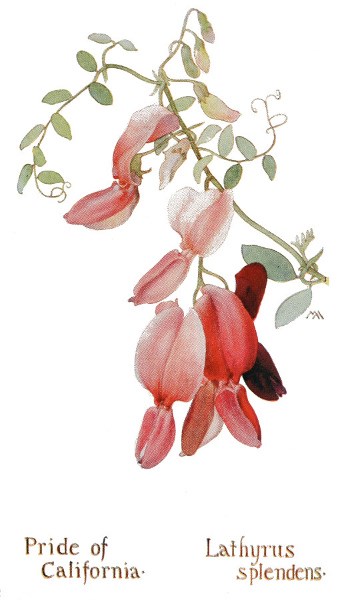
Pride of California – Lathyrus splendens.
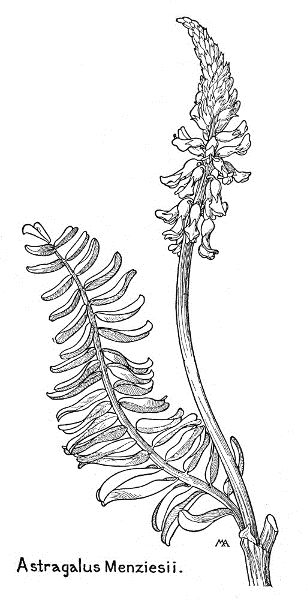
Astragalus Menziesii.
Pink Lady-fingers, Sheep-pod
Astrágalus Utahénsis
Pink
Spring, summer, autumn
Utah, Nev.
A pretty plant, unusual in coloring, the short stems spreading on the ground and springing from a short, perennial root; the foliage all very pale bluish-gray, covered with silvery down, the thickish leaflets from eleven to seventeen in number, the younger leaves and flower buds almost white. The flowers are about an inch long, in loose clusters, with flower-stalks from three to four inches long; the calyx long, pinkish-gray and downy, the standard pale pink, the wings deeper purplish-pink, the keel yellowish-pink. The pod is short, leathery, woolly, and stemless. This grows in dry, gravelly soil and in favorable situations makes low, circular clumps of foliage, suggesting the old-fashioned crochet lamp-mats that we used to see in New England farmhouses, for the pale leaves are symmetrically arranged in neat clusters and ornamented at intervals with pink flowers. Unlike, however, the worsted ornament, its coloring is delicately harmonious and beautiful.
Astrágalus nothóxys
Purple
Spring
Arizona
A very slender plant, with trailing stems, one or two feet long, the leaflets odd in number and downy on the under side. The flowers are about half an inch long, with a whitish, downy calyx and a bright purple corolla, shading to white at the base. This grows in mountain canyons and looks a good deal like a Vetch, except that it has no tendrils.
Rattle-weed, Loco-weed
Astrágalus pomonénsis
White
Spring
California
This is a straggling plant, a foot and a half tall, smooth all over, with stout stems and many bluish-green leaflets. The flowers are over half an inch long, with a very pale calyx and yellowish-white corolla, forming a rather pretty cluster, about three inches long. The pods are each over an inch long and much inflated, forming a large bunch, odd and very conspicuous in appearance.
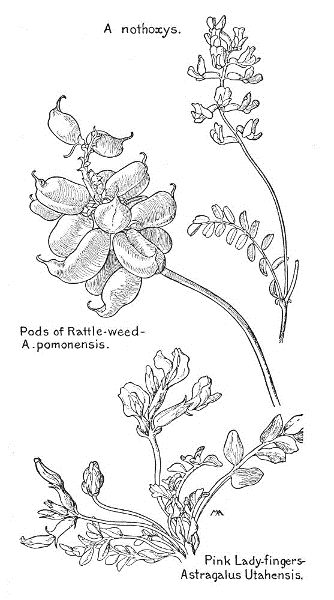
A. nothoxys.
Pods of Rattle-weed – A. pomonensis.
Pink Lady-fingers – Astragalus Utahensis.
Loco-weed
Astrágalus MacDoùgali
White, lilac
Spring
Arizona
An attractive plant, about a foot high, with straggling, reddish stems and delicate foliage. The flowers are over half an inch long, with a hairy calyx and pale lilac and white corolla, and form pretty clusters about two inches long.
There are many kinds of Hedysarum, some from Africa and only a few in this country; perennial herbs, sometimes shrubby; the leaflets toothless, odd in number; the flowers in handsome racemes, with bracts, on stalks from the angles of the stem; the calyx with five, nearly equal teeth; the standard rather large, round, or inverted heart-shaped, narrow at base, the wings oblong, shorter than the standard; the keel blunt, nearly straight, longer than the wings; the stamens in two sets of nine and one, not adhering to the corolla; the pod long, flat, and oddly jointed into several, strongly-veined, one-seeded, roundish divisions, which separate when ripe. The name is from the Greek, meaning "sweet-broom."
Hedýsarum pabulàre
Pink
Spring, summer
Utah
A very handsome and decorative plant, with large brilliant flower-clusters, contrasting well with the foliage and making spots of vivid color on dry plains and hillsides. It has many stems, springing from a rootstock, which are from eight to fifteen inches long, yellowish-green, ridged, and covered with inconspicuous down, the leaflets are light bluish-green, thickish, nine to seventeen in number, and the bracts are thin and dry. The flowers are about three-quarters of an inch long, with a pinkish-green and downy calyx, and the corolla all bright deep pink, fading to blue, with a veined standard. The pod has from three to five divisions. This flourishes at rather high altitudes, up to seven thousand feet, and is conspicuously beautiful near the entrance to Ogden Canyon in Utah.

